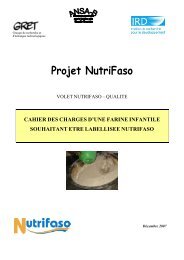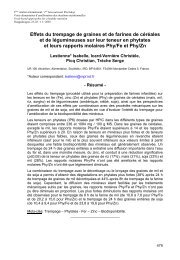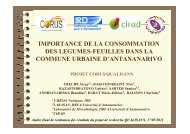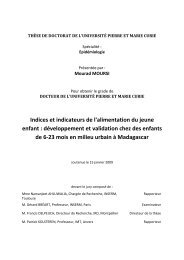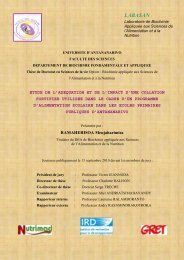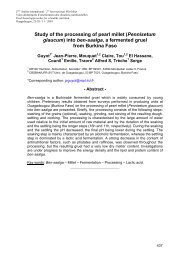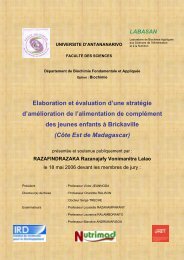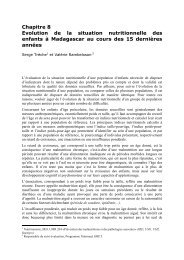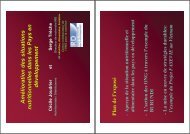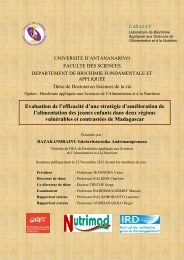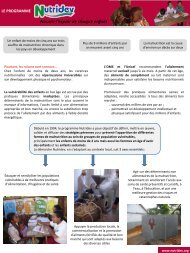THESE UNIQUE El Hassane Kéhien-Piho TOU - Nutridev
THESE UNIQUE El Hassane Kéhien-Piho TOU - Nutridev
THESE UNIQUE El Hassane Kéhien-Piho TOU - Nutridev
Create successful ePaper yourself
Turn your PDF publications into a flip-book with our unique Google optimized e-Paper software.
Projet d’article<br />
Table1. Results from morphological observations, Gram reaction, catalase activity and API 50<br />
CHL tests<br />
Percentage (%)<br />
Gram + 98<br />
Catalase - 94<br />
Gram + et Catalase - 92<br />
Homofermentative 58<br />
Lactobacilli (morphology) 80<br />
Glucose 100<br />
Fructose 100<br />
Maltose 72<br />
Sucrose 57<br />
Lactose 52<br />
Melibiose 57<br />
Raffinose 69<br />
As shown in table1, 57 and 69 % of LABs<br />
can ferment melibiose and raffinose,<br />
respectively. All strains fermented glucose<br />
and fructose, and 72 and 57 % fermented the<br />
main disaccharides of cereals maltose and<br />
sucrose, respectively. Surprisingly, only one<br />
strain fermented starch but it has been<br />
previously reported that API50CHL API<br />
strips often gave false negative results<br />
regarding starch fermentation, and therefore<br />
this test cannot enable to detect amylolytic<br />
LABs (Agati et al, 1998). It is interesting to<br />
observe that most of the LABs can ferment<br />
α-galactosides which are antinutritional<br />
factors. Therefore if for nutritional<br />
improvement of ben-saalga pulses and beans<br />
are added to millet in order to increase the<br />
protein and lipid content, it would be possible<br />
to rely upon the natural ability of the<br />
microbiota to remove the α-galactosides<br />
brought with these complementary raw<br />
materials.<br />
The phenotypic and biochemical tests showed<br />
that among the 184 strains isolated, 126 of<br />
the isolates were confirmed as LAB (73 %<br />
lactobacilli, 20 % cocci) and 5 % were<br />
presumptively identified as Bacillus sp.<br />
Consistently with the fermentation patterns<br />
obtained during fermentation kinetics<br />
experiments (Tou et al, 2006), 50 and 80 %<br />
76



